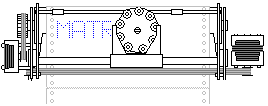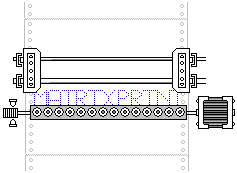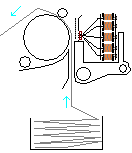Dot Matrix
It isn't clear where the idea of dot-matrix displays and printers originate but perhaps they were self evident from tapestry and painting on canvas. Dot Matrix printers emerged in the 1960s and in 1970 Digital Equipment Corporation (DEC) and Centronics (assisted by Brother) introduced the first commercial products.
Their predecessors, teleprinters, IBM Selectric golf-ball typewriters and daisy-wheel printers all use a type-element on a carriage for printing. What they all have in common is that the type element is a solid mirror-image of the letter to be formed. At any one time the printer has a fixed repertoir of glyphs in just one font. Daisy wheel printers could have quite a wide repertoir of 96 glyphs and by combining some (for instance overprinting, like Y -
) could print more characters. The operator could change the wheel and get a different font. Daisy-wheel printers could even produce graphics by hammering out a picture using the full-stop. It took ages.

Dot Matrix Head
The innovation with dot-matrix printers is to mount a set of fine pins on the carriage. One pin won't do- it would be just like the daisy-wheel printer making graphics by hammering away at the full-stop. As the carriage scans the page the vertical row of pins form the characters a line at a time.
Dot matrix was the most popular kind of printer in the 1980s. These days they are used for invoicing, dispatch and point of sale printers. They aren't so common as they once were.
The decline of dot-matrix techniques is partly because they are noisy and the print-quality wasn't very good. They were also troublesome in trivial ways, throwing off the ribbon for instance. This kind of problem happens when the platen-gap is misadjusted. Computer users are no longer used to dot matrix. Issues like operator expectation make or break a technology.

Dot Matrix pin
Dot matrix techniques are important. Laser, inkjet and thermal printers use the same bitmap techniques. A set of pins form characters by making a dot pattern or bit map on the page that merge in the eye. If your reading this on a screen it uses a similar technique, as do thermal, laser and inkjet printers.
The pins are driven by a solenoid. The pin strikes a ribbon and displaces a dot of ink onto the paper. The pin vibrates back and forth but not continually, it has a duty-cycle around 10-20%. Heat accumulating in the solenoid is a limit on print speed.

Serial matrix, head scans horizontally.
Most dot matrix printers use a serial
technique. A small number of pins sit on a carriage which scans across the page. The pins form the characters as they go. One pin would not be enough, the carriage would scan 9 or more times as often making things too slow. Manufacturers tried 7, 9, 18, 24 and even 48 pins to get better-formed characters. At 48 pins the characters were quite well-formed, but printheads were over-complicated. Most current printers use 9, 18, or 24 pins.
The main body of printer is the carriage. The basic idea has been around for a long time with Selectric typewriters and Diasywheel-printers, There are two rails running a bit more than the horizontal width of the paper. The carriage is mounted on these and can slide back and forth. The carriage is pushed and pulled by a motor, via a rubber belt. The mechanism is simple and long-lasting.

An alternative parallel
technique uses a whole pagewidth of pins. This gives a fast printer. In most cases there are 132 pins and they actually ‘shuttle’ through a 1/10th inch horizontal displacement so each pin forms the whole of one character, row after row. The obvious problem is the cost of all those pin mechanisms. Parallel dot-matrix has always had niche uses in labelling, utility billing and other applications where high speed is wanted but high quality isn't essential. Parallel dot-matrix is fast and reliable enough to have largely taken the market from band-printers ![]() .
.

Performance Limit
Limiting factor in what a dot-matrix printer can do is the print-pin. They are usually hardened steel and the bearing in the nose of the printhead that guides them is typically a hard mineral of some kind. The printhead pins wear against the ribbon which may seem surprising but over millions of actions and thousands of metres of ribbon it has an effect. The bottom pins that provide the descenders on lower case characters wear least and often protrude. Pins also wear against the bearings, so they become a slack fit and the dot positions become erratic.
The critical factor in making dot matrix printers reliable is the design of the printhead. There is an enormous range in printhead life, from 5 million to 2000 million characters. Many printers have easily replaceable plug-in printheads. Some dot-matrix designs had replaceable printhead pins. These days the whole head has to be replaced. Again at one time it was possible to repair a printhead, now that is rare.
Reliability
Dot matrix printers can't be completely reliable of course. To keep the print-pin relationship to the paper constant the carriage rails and bearings need fine tollerances and just a little lubrication. But paper and ribbon dust sticks in any excess lubrication and jams the movement, The rails and bearings need cleaning from time to time. The carriage belt will wear out and so might it's drive cog. The carriage cable is constantly flexing and will need replacing. Any opto-sensors will get dusty and then the printer may go beserk. Many of these faults are not too difficult to deal with, although stripping a printer down, cleaning it and spotting the faults may take time.
Tractor feed has been retained on dot matrix designs. Reliable paper feed is more important to users than cut-sheet paper. There are dot-matrix printers with cut-sheet feeders but if you want letter-quality correspondence then an inkjet or laserprinter is a better choice.
Dot-Matrix Market Context
Dot matrix printers rose to prominence in the 1980s. Users wanted fonts and graphics that band-printers and daisy-wheel printers could not provide. Speed was quite good; one or two lines per second. (Band-printers can be 10 times faster). Print quality wasn't great (Daisy-wheel type still beats laser printers). Dot matrix was more affordable than early inkjets and laser-printers.
Several manufacturers reputations were made with dot-matrix. Facit, Olivetti, Star, Tally, Panasonic, Philips and NEC had significant printer businesses.
Centronics had an early lead but in 1987 the printer business was sold to parallel dot-matrix company GENICOM, who in 1997 bought DEC's printer division. Genicom itself merged with Tally and TallyGenicom was acquired by Printronix in 2009. Intellectual property rights belong variously to Printronix and DASCOM.
Brother, Epson, OKI and Printronix came to prominence with dot-matrix designs and have in various ways rode the waves of change in technology.
Copyright G Huskinson & MindMachine Associates Ltd 2012
